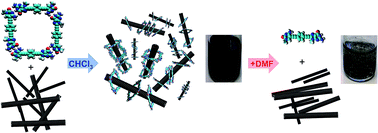当前位置:
X-MOL 学术
›
Chem. Sci.
›
论文详情
Our official English website, www.x-mol.net, welcomes your feedback! (Note: you will need to create a separate account there.)
Reversible dispersion and release of carbon nanotubes via cooperative clamping interactions with hydrogen-bonded nanorings†
Chemical Science ( IF 8.4 ) Pub Date : 2018-04-04 00:00:00 , DOI: 10.1039/c8sc00843d Raquel Chamorro 1 , Leire de Juan-Fernández 2 , Belén Nieto-Ortega 2 , Maria J Mayoral 1 , Santiago Casado 2 , Luisa Ruiz-González 3 , Emilio M Pérez 2 , David González-Rodríguez 1, 4
Chemical Science ( IF 8.4 ) Pub Date : 2018-04-04 00:00:00 , DOI: 10.1039/c8sc00843d Raquel Chamorro 1 , Leire de Juan-Fernández 2 , Belén Nieto-Ortega 2 , Maria J Mayoral 1 , Santiago Casado 2 , Luisa Ruiz-González 3 , Emilio M Pérez 2 , David González-Rodríguez 1, 4
Affiliation

|
Due to their outstanding electronic and mechanical properties, single-walled carbon nanotubes (SWCNTs) are promising nanomaterials for the future generation of optoelectronic devices and composites. However, their scarce solubility limits their application in many technologies that demand solution-processing of high-purity SWCNT samples. Although some non-covalent functionalization approaches have demonstrated their utility in extracting SWCNTs into different media, many of them produce short-lived dispersions or ultimately suffer from contamination by the dispersing agent. Here, we introduce an unprecedented strategy that relies on a cooperative clamping process. When mixing (6,5)SWCNTs with a dinucleoside monomer that is able to self-assemble in nanorings via Watson–Crick base-pairing, a synergistic relationship is established. On one hand, the H-bonded rings are able to associate intimately with SWCNTs by embracing the tube sidewalls, which allows for an efficient SWCNT debundling and for the production of long-lasting SWCNT dispersions of high optical quality along a broad concentration range. On the other, nanoring stability is enhanced in the presence of SWCNTs, which are suitable guests for the ring cavity and contribute to the establishment of multiple cooperative noncovalent interactions. The inhibition of these reversible interactions, by just adding, for instance, a competing solvent for hydrogen-bonding, proved to be a simple and effective method to recover the pristine nanomaterial with no trace of the dispersing agent.
中文翻译:

通过与氢键纳米环的协同夹紧相互作用实现碳纳米管的可逆分散和释放†
由于其出色的电子和机械性能,单壁碳纳米管(SWCNT)是用于下一代光电器件和复合材料的有前途的纳米材料。然而,它们的溶解度较低,限制了它们在许多需要对高纯度单壁碳纳米管样品进行溶液处理的技术中的应用。尽管一些非共价官能化方法已证明其在将单壁碳纳米管提取到不同介质中的实用性,但其中许多方法会产生短暂的分散体或最终受到分散剂的污染。在这里,我们引入了一种前所未有的策略,该策略依赖于协作夹紧过程。当 (6,5)SWCNT 与能够通过Watson-Crick 碱基配对在纳米环中自组装的二核苷单体混合时,会建立协同关系。一方面,氢键环能够通过包围管侧壁与单壁碳纳米管紧密结合,从而实现有效的单壁碳纳米管解束,并在宽浓度范围内生产具有高光学质量的持久单壁碳纳米管分散体。另一方面,单壁碳纳米管的存在增强了纳米环的稳定性,单壁碳纳米管是环空腔的合适客体,有助于建立多种协同非共价相互作用。通过添加例如氢键竞争溶剂来抑制这些可逆相互作用,被证明是一种简单有效的方法来回收原始纳米材料,且不含有任何分散剂。
更新日期:2018-04-04
中文翻译:

通过与氢键纳米环的协同夹紧相互作用实现碳纳米管的可逆分散和释放†
由于其出色的电子和机械性能,单壁碳纳米管(SWCNT)是用于下一代光电器件和复合材料的有前途的纳米材料。然而,它们的溶解度较低,限制了它们在许多需要对高纯度单壁碳纳米管样品进行溶液处理的技术中的应用。尽管一些非共价官能化方法已证明其在将单壁碳纳米管提取到不同介质中的实用性,但其中许多方法会产生短暂的分散体或最终受到分散剂的污染。在这里,我们引入了一种前所未有的策略,该策略依赖于协作夹紧过程。当 (6,5)SWCNT 与能够通过Watson-Crick 碱基配对在纳米环中自组装的二核苷单体混合时,会建立协同关系。一方面,氢键环能够通过包围管侧壁与单壁碳纳米管紧密结合,从而实现有效的单壁碳纳米管解束,并在宽浓度范围内生产具有高光学质量的持久单壁碳纳米管分散体。另一方面,单壁碳纳米管的存在增强了纳米环的稳定性,单壁碳纳米管是环空腔的合适客体,有助于建立多种协同非共价相互作用。通过添加例如氢键竞争溶剂来抑制这些可逆相互作用,被证明是一种简单有效的方法来回收原始纳米材料,且不含有任何分散剂。



























 京公网安备 11010802027423号
京公网安备 11010802027423号